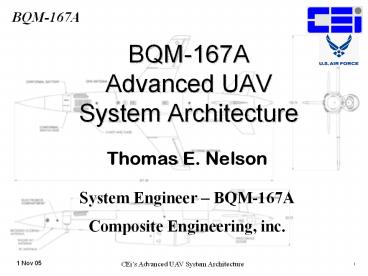BQM-167A Advanced UAV System Architecture - PowerPoint PPT Presentation
1 / 27
Title:
BQM-167A Advanced UAV System Architecture
Description:
Integrate New Engine with Greater Thrust and Better Efficiency ... Software Architecture. Integrated Flight Controller ... Umbilical System and Testing ... – PowerPoint PPT presentation
Number of Views:125
Avg rating:3.0/5.0
Title: BQM-167A Advanced UAV System Architecture
1
BQM-167AAdvanced UAV System Architecture
- Thomas E. Nelson
- System Engineer BQM-167A
- Composite Engineering, inc.
2
What is the BQM-167A?
3
High PerformanceSubscale Aerial Target
4
The CEi Objective
- Provide Advanced Replacement for Existing High
Subsonic Aerial Targets - Integrate New Engine with Greater Thrust and
Better Efficiency - Improved Shape for Better Performance and
Increased Fuel and Payload Capacity - Advanced System Architecture with Microelectronics
5
AFSAT Requirements
- Endurance
- 60 min. at 15k ft., 30 of 60 at MIL power
- Airspeed Range
- 250 KCAS to .90 Mach
- Formation Flight
- Up to 4 Aircraft
- Threat Representative Maneuvers
- Payloads
- 300 pounds total
- Internal 100 pounds growth capacity
- Wings 150 pounds per Wing
- Launch Modes
- Land
- Recovery
- Land Water
6
AFSAT Requirements
- Sustained g _at_ 10k ft
- -2g to 6g
- Operating Altitude
- 50 ft to 50k ft
- Payload Systems
- ALE-47
- EA Pods
- IR Augmentation
- Visual Augmentation
- Smoke
- Paint
- Strobe Light
- Control System
- Manually Flown
- Automated Maneuvers
7
Internal Emphasis
- Configuration Flexibility
- Increased Fuel and Payload Capacity
- Flexible Engine Options
- Significantly Reduced System Cost
- Reduced Parts Count
- OTS Materials and Hardware
- Maintainability/Reparability
- Available Power and Volume for Payloads
8
Distributed Digital Architecture
9
Spare Digital / Analog Signals
- Communications Channels
- RS-232, RS-422, and CAN Buses
- D-to-A and A-to-D Signals
- 16-, 12-, and 8- Bits
- Payload and Spare Discrete Controls
- Ground, Open, and 28 VDC
- Relay Activation Controls
- 5, 15, and 25 Amp
- Servo Actuator Controls
10
Software Architecture
- Integrated Flight Controller
- C Code, Interrupt Based Operations (10mSec
timer) - Control Laws Implement Autopilot Operations
- Special Vehicle Interfaces and Controls
- Upgradeable to JAUS Standard/Compliance
- GRDCS Communications
- Digital Signal Processor, RS-422 Serial
Communications, RF Command and Control - Autopilot Sensor
- C Code, RS-422 Serial, Full Integrated
Navigation System (INS) solution, 17-State Kalman
Filter
11
Software Architecture
- Engine Control Unit
- C Code, RS-422 Serial, Total Engine Operations
- ALE-47 System
- C Code, RS-422 Serial, ALE-47 Sequencer
Operations - IFF System
- C Code, RS-422 Serial, Mode 3A / 3C Operations
- Umbilical System and Testing
- National Instrument LabView Code, RS-422 Serial,
Command, Control, and Test Operations
12
Airframe Layout
13
BQM-167A Specifications
Length 20.1 feet
Span (Clean) 10.5 feet
Maximum Weight 2050 pounds
Maximum Speed 0.93 Mach
Maximum Altitude 50,000 feet
Maneuverability 9g _at_ 10,000 feet
Maximum Climb 25,000 feet/minute
Propulsion 1000 lb. thrust turbojet
Maximum Endurance Over 3 hours
14
Flight Performance Demonstration
- Demonstrated Predicted Performance and Payload
Capabilities - Demonstrated Operational and Maintainability
Aspects - Quickly Resolved Anomalies (All Minor)
15
Launch Recovery
16
Demonstrated Flight Performance
- Maximum Airspeed 0.90 Mach
- Payload Carriage
- 150 lb / Wing
- 300 lb Internal
- 7.0 Cubic Feet
- Maximum Altitude 51,600 feet
- Maneuverability 9g Sustained 11,000 feet
17
Demonstrated Flight Performance
- Land Water Recovery
- Manual Automated Control
- Preprogrammed Maneuvers
- G-Turns (Airspeed Altitude Hold)
- Barrel Roll
- Constant G Weave
- Split-S
- Slice Pitchback
18
Major Program Milestones
19
Current Activities
- Flight Performance Demonstration
- First FPD Flight December 8, 2004
- 10 of 12 Flights Completed
- No Airframes Lost or Significantly Damaged
- Demonstrated 95 of Requirements by Flight 6
- LRIP 12 On Order 48 Aircraft Total
- Delivered First Articles (2 Aircraft) in Oct. 2004
20
Future of the BQM-167A
21
Payloads Expansion
22
Expanded IR Configuration
23
Enhanced EA Configuration
24
Imminent Milestones
- Ground Support Equipment
- First Spares Order
- New Launch Rail Delivery in Nov. 2005
- FAAT Aircraft Delivery in Oct. 2005
- FAAT Flights Start in Nov. 2005
- IOC Scheduled for June 2006
25
BQM-167A Program Lessons Learned
26
Government-Contractor Team
- Open technical communications between
Government-Contractor team members - Common objective lead to distribute system
architecture with spares and expandability - Distributed architecture enabled concurrent
engineering activities to occur
Working Together With a Common Vision, The Best
Target for the Customer
27
BQM-167A, Multi-role UAV
QUESTIONS?































